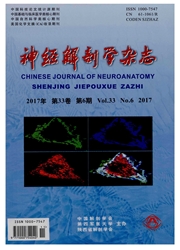

 中文摘要:
中文摘要:
目的:探讨次声对成年大鼠海马齿状回颗粒细胞下层(subgranular zone,SGZ)神经干细胞增殖抑制作用的细胞学机制。方法:成年雄性Sprague-Dawley大鼠置于次声压力舱,连续暴露于16Hz、130dB次声7d(2h/d)后,给与小胶质细胞抑制剂米诺环素(50mg/kg,药物组,n=16)或等体积生理盐水(对照组,n=16),同时设立不经次声作用的正常对照组(n=16);分别于1、3、7和14d处死大鼠,利用免疫组织化学法以Iba1、OX42标记小胶质细胞,Brdu标记增殖的神经干细胞。结果:小胶质细胞在SGZ区分布较为密集;与正常对照组相比,次声暴露后3d时OX42免疫反应性明显增强、SGZ区BrdU阳性细胞数目减少最为明显(P〈0.01);米诺环素可显著改善次声暴露后BrdU阳性细胞数目的减少(P〈0.01)。结论:小胶质细胞活化参与次声抑制成年大鼠海马SGZ区神经干细胞的增殖。
 英文摘要:
英文摘要:
Objective: To explore the cellular mechanisms underlying infrasound-induced suppression of neural stem cell proliferation in the subgranular zone (SGZ) of hippocampal dentate gyrus of adult rats. Methods: Male Sprague-Dawley rats were placed in a infrasonic chamber and exposed to 16 Hz at 130 dB infrasound for 2 h/d in consecutive 7 days. Then rats were treated with microglia inhibitor minocycline ( the drug group, 50 mg/kg, n = 16) or same volume of saline ( the control group, n = 16) intraperitoneally. The rats without infrasound exposure and drugs treatment were established as the normal control group ( n = 16). At 1,3, 7 or 14 d following infrasound exposure, the rats were sacrificed and their brain sections were subjected to immunostaining of Iba1, OX42 ( two markers for mieroglia), and BrdU ( a marker for proliferating cells). Results: Microglia was distributed abundantly in the SGZ region. Relative to the normal controls, at 3 d following infrasound exposure, OX42 immunoreactivity was most enhanced and BrdU-positive cells were decreased to the lowest number in the SGZ ( P 〈 0.01 ). Minocycline attenuated the infrasound-induced decrease of BrdU-positive cell number significantly (P 〈0.01 ). Conclusion: Microglial activation was involved in infrasound-induced suppression of neural stem cell proliferation in hippocampal SGZ of adult rats.
 同期刊论文项目
同期刊论文项目
 同项目期刊论文
同项目期刊论文
 Notch-Rbpj signaling is required for the development of noradrenergic neurons in the mouse locus coc
Notch-Rbpj signaling is required for the development of noradrenergic neurons in the mouse locus coc Epigallocatechin gallate (EGCG) attenuates infrasound-induced neuronal impairment by inhibiting micr
Epigallocatechin gallate (EGCG) attenuates infrasound-induced neuronal impairment by inhibiting micr Aspirin promotes oligodendrocyte precursor cell proliferation and differentiation after white matter
Aspirin promotes oligodendrocyte precursor cell proliferation and differentiation after white matter Ginsenoside Rd attenuates tau protein phosphorylation via the PI3K/AKT/GSK-3beta pathway after trans
Ginsenoside Rd attenuates tau protein phosphorylation via the PI3K/AKT/GSK-3beta pathway after trans 期刊信息
期刊信息
